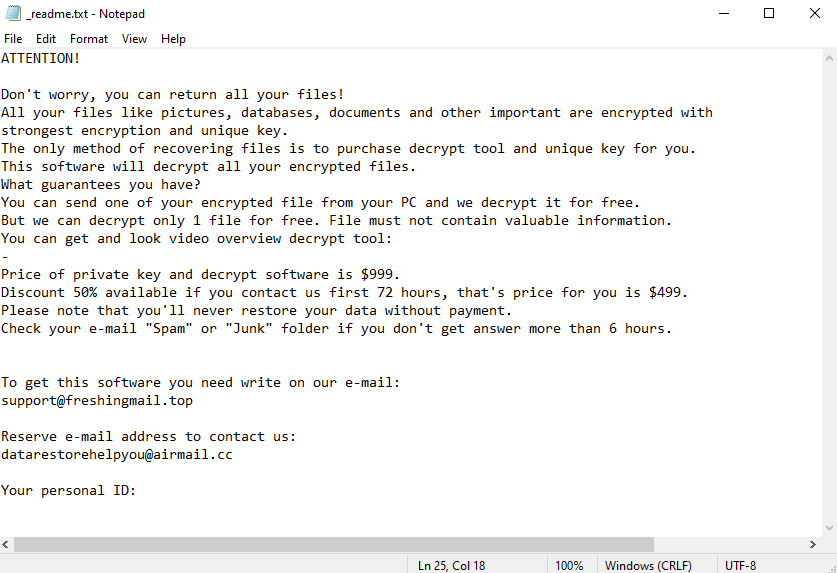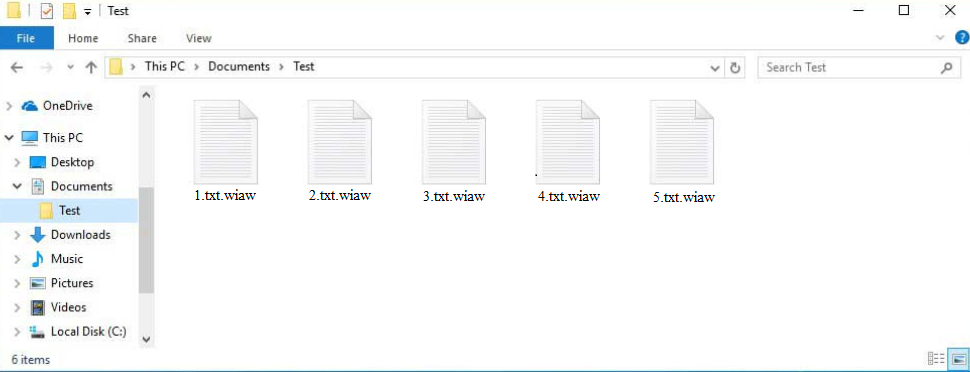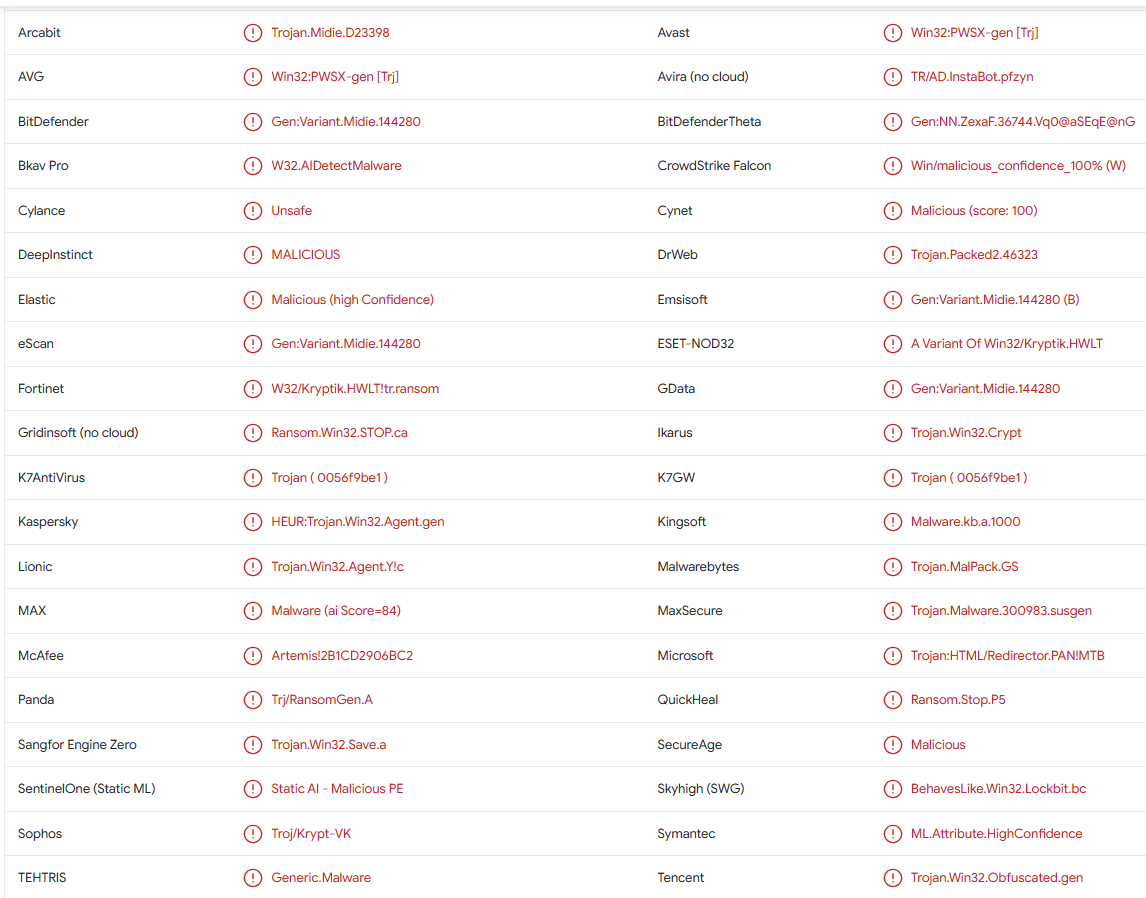Wiaw ransomware is malware that encrypts files. It’s part of the Djvu/STOP ransomware family and is considered to be a very dangerous infection. Once files have been encrypted, it will not necessarily be possible to recover them.
As soon as it’s initiated, the ransomware will start encrypting files. While it’s encrypting files, it will show a fake Windows update window to distract users from what’s going on.
The ransomware’s main targets are personal files, including photos, videos, and documents. Which files have been encrypted will be immediately obvious because they will have .wiaw attached to them. For example, image.jpg will become image.jpg.wiaw when encrypted. Files with that extension will not be openable until you run them through a decryptor.
You will find a _readme.txt ransom note in folders that contain encrypted files. The note explains how you can buy the decryptor. The price is $999 but there’s supposedly a 50% discount for users who contact the cybercriminals within the first 72 hours. The cybercriminals also promise to decrypt one file for free as long as it does not contain any important information.
Below is the full Wiaw ransomware ransom note:
ATTENTION!
Don’t worry, you can return all your files!
All your files like pictures, databases, documents and other important are encrypted with strongest encryption and unique key.
The only method of recovering files is to purchase decrypt tool and unique key for you.
This software will decrypt all your encrypted files.
What guarantees you have?
You can send one of your encrypted file from your PC and we decrypt it for free.
But we can decrypt only 1 file for free. File must not contain valuable information.
You can get and look video overview decrypt tool:
–
Price of private key and decrypt software is $999.
Discount 50% available if you contact us first 72 hours, that’s price for you is $499.
Please note that you’ll never restore your data without payment.
Check your e-mail “Spam” or “Junk” folder if you don’t get answer more than 6 hours.To get this software you need write on our e-mail:
support@freshingmail.topReserve e-mail address to contact us:
datarestorehelpyou@airmail.ccYour personal ID:
Paying the ransom may seem like a good idea if you have no other option but you should be aware that you will not necessarily get a decryptor just because you pay. Ransomware is operated by cybercriminals, and they are unlikely to feel any kind of obligation to help victims. There have been many ransomware victims who paid for a decryptor but did not receive one. So while the decision of whether to pay the ransom is yours, you should be aware of the risks.
If you have a backup of your files, you can start file recovery as soon as you remove Wiaw ransomware from your computer. We strongly recommend using an anti-malware program to delete Wiaw ransomware because it’s a complicated infection.
If you do not have backup, back up the encrypted files and wait for a free Wiaw ransomware decryptor to be released. If it does get released, it will be available on NoMoreRansom.
How did ransomware enter my computer?
Malicious actors spread ransomware in several different ways, including email attachments and torrents. If you have bad browsing habits, you’re much more likely to infect your computer with malware. One of the most effective ways of avoiding malware is to develop better online habits and familiarize yourself with the most common malware distribution methods.
Many users have a habit of opening email attachments without checking them first, which malicious actors take advantage of. Malicious files are attached to emails, and when said files are opened by users, the computers become infected. These types of emails are usually part of a massive malspam campaign and target a large number of users at the same time. Because these emails are not personalized, they are usually quite obviously malicious.
It’s common for malware-carrying emails to at least resemble emails sent by legitimate companies. For example, the emails may be made to look like parcel delivery notifications. Senders often claim that the attached files are important documents that need to be reviewed immediately. By creating a sense of urgency, malicious actors pressure users into opening the files without double-checking. But one thing that often gives these emails away is grammar and spelling mistakes. For whatever reason, malware-ridden emails are often full of mistakes. You will never see obvious mistakes in emails sent by legitimate companies because they look unprofessional, so the mistakes are usually an immediate giveaway.
Malicious emails usually address users with generic words like User, Member, Customer, etc., instead of using users’ names as you’d normally see in legitimate emails. An email from a company whose services you use will always address you by name (or rather the name you have given them) to make the email more personalized. However, malicious actors target many users with the same email so they use generic words.
In some cases, malicious emails can be more sophisticated. This is usually the case when malspam targets someone specific. Such an email would have no mistakes and have information that would give the email credibility. Because there are more sophisticated malicious emails, it’s always a good idea to scan all unsolicited email attachments with anti-virus software or VirusTotal before opening them.
You can also often find malware in torrents, especially in torrents for entertainment content like movies, TV series, video games, etc. Torrent sites are more often than not poorly moderated, so they are full of malware. So not only is pirating using torrents content theft but it’s also dangerous for users’ computers and data.
How to delete Wiaw ransomware
Whether you have a backup or not, you need to remove Wiaw ransomware from your computer. Ransomware is a complicated infection, so it’s recommended to use an anti-malware program. If you have a backup, you can access it as soon as you fully delete Wiaw ransomware. Keep in mind that if ransomware is still present when you connect to your backup, your backed-up files will become encrypted as well.
If you do not have a backup, your only option is to wait for a free Wiaw ransomware decryptor to be released. Malware researchers are sometimes able to crack the ransomware and develop a decryptor to help victims for free. However, it’s not always possible. If a free Wiaw ransomware decryptor does get released, it will be posted on NoMoreRansom. There may be many fake decryptors being advertised on questionable websites so we caution you to be very careful because you could end up with more malware. If you cannot find a decryptor on NoMoreRansom, it likely does not exist.
Wiaw ransomware is detected as:
- Win32:PWSX-gen [Trj] by AVG/Avast
- Gen:Variant.Fragtor.515893 by BitDefender
- Trojan.MalPack.GS by Malwarebytes
- Trojan:HTML/Redirector.PAN!MTB by Microsoft
- A Variant Of Win32/Kryptik.HWLT by ESET
- HEUR:Trojan.Win32.Agent.gen by Kaspersky
Site Disclaimer
2-remove-virus.com is not sponsored, owned, affiliated, or linked to malware developers or distributors that are referenced in this article. The article does not promote or endorse any type of malware. We aim at providing useful information that will help computer users to detect and eliminate the unwanted malicious programs from their computers. This can be done manually by following the instructions presented in the article or automatically by implementing the suggested anti-malware tools.
The article is only meant to be used for educational purposes. If you follow the instructions given in the article, you agree to be contracted by the disclaimer. We do not guarantee that the artcile will present you with a solution that removes the malign threats completely. Malware changes constantly, which is why, in some cases, it may be difficult to clean the computer fully by using only the manual removal instructions.


